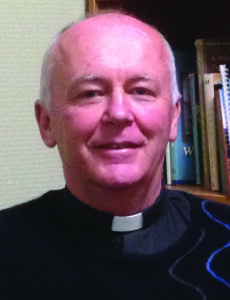St John of the Cross

Fr Carl Telford SM
The Living Flame of Love
Part 3 of 5
The next major work of St John of the Cross and his last, is called The Living Flame of Love, a poem, only twenty-four lines long, and his commentary.
It tells the story of the fulfilment of love, the spiritual marriage, the final transformation by God. It does not tell of purification but of enjoyment and rest and celebration. St John writes each of his major works with the whole journey in mind. This work is about the fulfilment of the journey. Hence, its importance for us today. We go through the Dark Night to reach the perfect light and fire of love in this life, if God so wills.
The commentary was written in 1585, probably in two weeks, at the request of the layperson Dona Ana de Penalosa, whom he directed. She asked for a deeper explanation of the poem.
It is his shortest work, and perhaps his most sublime, according to Professor E Allision Peers, and with possibly greater eloquence and ardour than The Spiritual Canticle. Professor Peers also says, “We can sense almost a period of superhuman insight and power of expression.” High praise! He also writes, “it is probably true to say that no other author, either before or since, has written of Mystical Union with the unalloyed beauty which we find in this poem and its interpretation. St John is well known as the Doctor of the Night but he is equally the Doctor of Love.The Living Flame is a work to be prayed with rather than only studied.”
The poem deals with union with God, and not the path to union. There is no progressive movement from stage to stage. It is a song of praise at the goodness of God in bringing souls to this state of closeness to his love. He writes, ”These stanzas speak of a love deeper in quality and more perfect within this very state of transformation.”
The Living Flame is made up of four stanzas, with St John’s commentary on each stanza. He writes humbly as he begins the commentary, “everything I say is as far from the reality as is a painting from the living object represented.” However, it is not a perfect work! There are diversions: for example, he spends a long time scolding foolish spiritual directors, or rather, warning fervent people away from such unwise directors.
Stanza 1
The poem begins:
O living flame of love
that tenderly wounds my soul
in its deepest centre!
Since now you are not oppressive,
now consummate! If it be your will
tear through the veil of this sweet encounter.
It explains the nature of the flame,
the love of the Holy Spirit, and where it abides, in the very depths of our soul.
The soul is now feasting with the Holy Spirit so close to God. It explains the desire for glory, the veil of separation and the wound of love. The soul is held in an intimacy, secure, substantial and delectable.

An example of a cautery
Stanza 2
This tells of the Trinity at work. The cautery, an instrument for burning, is the Holy Spirit; the hand is the Father bringing transformation and the delicate touch is the Son, bringing eternal life. In fact, the soul is longing to die, to know this life in its fullness, which it is unable to access fully in this life.
 Stanza 3
Stanza 3
This verse speaks of the splendours produced by the lamps, which transmit light and give off warmth. The soul, now purified and hollowed out in the dark nights, is ready for God’s presence within. St John explains the soul’s gift to God. This stanza about the three blind guides, also contains the long discourse on ignorant spiritual directors.
Stanza 4
The divine love is now awakening with ineffable tenderness within the soul, and in its various forms. God is within the person and enables the person to participate in the very breathing of the Holy Spirit. In fact, St John is unable to really explain God’s goodness, and he leaves the last line of stanza four without commentary.
Finally, this Living Flame can seem remote from our more ordinary lives. But the depths explained in the Living Flame do not cease to inspire us. For example, during the life of St Therese of the Child Jesus, St John of the Cross’s writings were a deep source of hope, nourishing her at a pivotal time in her spiritual growth for two years, 1890-1891. No one else could do that.
When she read St John’s words, “the more God wants to give us, the more he increases our desires,” it launched her on the road of confidence as it explained to her, as if for the first time, the key to her spiritual path. The fire of love fell upon her and can upon us if we desire it.
St John of the Cross, pray for us.
 Entries(RSS)
Entries(RSS)